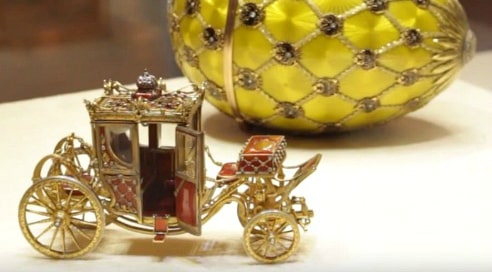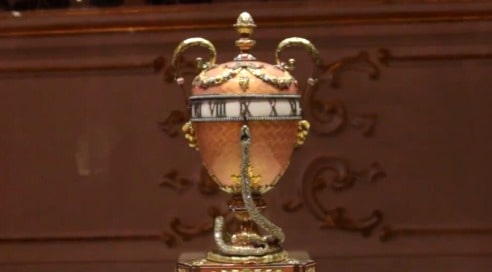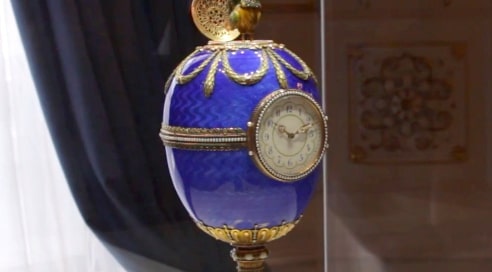Everybody knows something or at least once heard about Fabergé eggs. These small wonders are among the most expensive jewelry in the world and are a popular must-visit during Russia vacation.
Carl Fabergé produced a variety of jewelry, but it was eggs that made him renowned for ages. So, where did Faberge eggs originate, who designed Faberge eggs, what do Faberge eggs symbolize, and why was an egg shape chosen for these incredibly expensive treasures? Let's find out!
The History of Fabergé
The author of the eggs – Carl Fabergé – was born in St. Petersburg, Russia in 1846 in a family of a German from Estonia and daughter of a Danish artist. In 1842, his father founded a jewelry company in St. Petersburg, which 40 years later, under the leadership of Carl, attracted Russian Emperor Alexander III during his visit to the annual exhibition. Since then the Fabergé Company has begun to receive exclusive orders from the royal family. Soon after that Fabergé products became popular and of a great demand all over Europe.
The first Fabergé egg appeared in 1885. It was commissioned by the Russian emperor Alexander III as an Easter gift for his wife Maria Feodorovna. Nevertheless, this egg had its prototype as a range of jewelry Easter eggs with a hen-surprise inside were made in the XVIII century. Usually, a tiny crown was hidden inside the hen and contained a ring. Fabergé's first egg created in 1885 was of the same pattern. Later the Fabergé firm created a number of such Easter eggs.
Fun Fact
The first Fabergé egg appeared in 1885. It was commissioned by the Russian emperor Alexander III as an Easter gift for his wife Maria Feodorovna.
Gifts Worthy for the Emperors: Faberge Eggs
So why are Faberge eggs important to Russian culture? There are 71 Fabergé eggs in the world, but only 54 of them are Imperial.
Alexander III founded the Easter tradition of presenting Fabergé eggs to his wife Maria Feodorovna, which was continued by his son – Nicholas II after Alexander's death. Nicholas II started to give Fabergé Easter eggs both to his wife Alexandra Feodorovna and his mother – Maria Feodorovna.
Each Imperial egg always had a unique design and contained a new surprise inside. The firm began to develop these eggs a year in advance for next Easter. There are also 15 eggs made by Fabergé for individuals, yet these eggs usually replicated the Imperial ones.
Imperial Fabergé Eggs have a great variety of subjects. There are Russian eggs with clocks as well as eggs with different figures and a variety of miniatures found inside. As such, there was an egg which contained 12 rotating thumbnails with images of the Emperor's memorable places.

The most expensive of all Fabergé creations, paid by the Romanovs, was the egg "Winter" made of diamonds, crystals and opals. The surprise of this egg was a basket with anemones.
Sadly some of the Fabergé eggs were lost during the Revolution of 1917. Most of them were transported to the Kremlin, where they were preserved until 1930. In 1930 many items were sold due to the lack of funds of the Soviet government.
Many of the eggs were bought by Armand Hammer and Emmanuel Snowman Vartsky. Bertie Charles Forbes was among the ardent collectors of Fabergé eggs as well, his collection consisted of 11 Imperial and 4 private Fabergé eggs. In 2004 this collection was put up for auction and was entirely bought out by Russian oligarch Viktor Vekselberg. So, some of the eggs returned to their homeland.
.jpg)
Did you know?
The most luxurious of all Fabergé masterpieces, paid by the Romanovs, was the egg "Winter" richly decorated with diamonds, crystals and opals. The hidden surprise of this egg was a basket with anemones.
Where to see Faberge Eggs in Russia
But what is the current location of the eggs? Most Faberge eggs are in Russia in museums in Moscow and St. Petersburg. Today the Russian collection of real Fabergé eggs can be seen in the Kremlin Armory and the Vekselberg Collection is housed in the Fabergé Museum in St. Petersburg.
Plus there are some exhibits in the Russian National Museum and the Mineralogical Museum of Russian Academy of Science. All of these can be visited during the special Fabergé eggs tour to Russia.
Each Imperial egg always had a unique design and contained a new surprise inside. The firm began to develop these eggs a year in advance for next Easter. There are also 15 eggs made by Fabergé for individuals, yet these eggs usually replicated the Imperial ones.
In the Armory, which belongs to the Moscow Kremlin museums, visitors can see ten Imperial Easter eggs with surprises. Among them are: the "Memory of Azov" egg holding a miniature model of the cruiser of the same name; the "Trans-Siberian Railway" decorated with a map of the Russian Empire and containing a tiny train.

Continuing the list are the biggest Fabergé egg "Moscow Kremlin"; the "Alexander Palace" egg with the model of the Palace in Tsarskoe Selo; the "Romanov Tercentenary" egg with a globe inside; the "Steel Military" egg with the picture of the visit of Emperor Nicholas II and his heir to the troops; the "Bouquet of Lilies Clock"; the "Clover" egg; the "Standart Yacht" and the "Alexander III Equestrian".
The Vekselberg Collection is on display at the Museum, bearing the name of Carl Fabergé, located in the Shuvalov Palace in St. Petersburg. The largest collection in the world includes eleven imperial Easter eggs.
They are the following: the "Hen" – the very first Imperial egg and the simplest one: white, a yolk inside, then a hen, and a ruby crown inside; the "Renaissance" egg; the "Rosebud" with a rose inside; the "Imperial Coronation Egg" (the most famous Fabergé egg with a copy of an imperial carriage).

Among other antiques are the blue "Chanticleer" egg with a clock; the "Lilies-of-the-Valley" egg holding medallions of Emperor Nicholas II and his two oldest daughters; the "Cockerel" egg with a singing popping cock; as well as the "Fifteenth Anniversary"; the "Bay Tree"; the "Order of St. George" and the "Duchess of Marlborough" eggs.
The egg "Constellation" can be seen in the Mineralogical Museum in Moscow. The egg was started in 1917 but was not completed due to the tragic events of the Revolution. The "Rothschild" egg with the automatic Cockerel is located in the State Hermitage Museum of St. Petersburg.
Sadly, many of the thousands of Faberge masterpieces which were owned by the royal Romanov family have been lost. Some are now gems of private collections all around the globe, and if you're wondering how many Faberge eggs are still missing, tragically, the location of 8 Faberge Imperial eggs is still unknown.
Top places to see farge collections in Russia:
- Kremlin Armory, Moscow
- Fabergé Museum, St. Petersburg
- Russian National Museum, Moscow
- Mineralogical Museum, Moscow
So, you see, each of the Fabergé eggs has its own destiny and history. The Faberge egg value is priceless, and thus to get a better insight of these precious treasures, travel to Russia and see the original eggs in the Fabergé Museum, St. Petersburg with your own eyes. We advise you to take a Fabergé eggs tour to see all of these incredible works of art!
